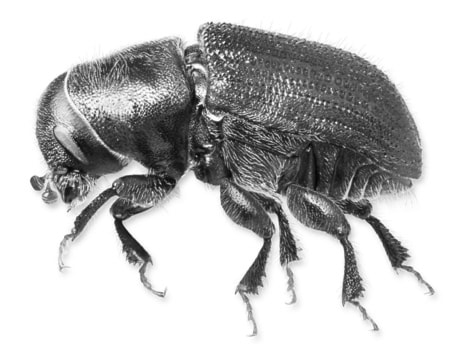EDMONTON — Alberta had some success this winter holding the line on the mountain pine beetle, but is looking for help to keep the rapacious, forest-killing critter from going national.
“The initial attack on this thing is a provincial responsibility,” Mel Knight, minister of sustainable resource development, told a news conference Thursday.
“But as we look at the map and see the potential for these beetles to move across boundaries and get into the northern boreal forest, there’s going to have to be more effort applied.”
The province has spent $300 million to control the beetle that first appeared in British Columbia, swarmed over the Rocky Mountains about six years ago and began attacking stands of pine trees in Alberta.
The federal government has delivered $18.5 million in assistance. Knight said he’s “not uncomfortable” with the amount, but more cash and help with research will be needed.
“I think the federal government has an understanding of the seriousness of this situation,” he said.
“I think what’s going to be required of me now is to get in front of the federal minister and some of our counterparts in other parts of the country.”
The battle can be won, he suggested.
“We’re entrenched in this thing now. We think within a decade to two decades we would be able to manage these pests in Alberta.”
Knight said about six million hectares of pine forest in the province is at risk. Fish and wildlife, tourism, watersheds and the $8.3-billion forestry industry all stand to be hurt.
He presented results that showed a wide range of over-winter survival rates for the beetles. The bugs managed to survive or thrive in the northwest and central parts of the province, but declined in the southwest and along the eastern edge of the infestation.
The mixed results come despite the fact that 600 workers destroyed and burned 170,000 infested trees last winter in the high-risk west-central region to keep the bugs from jumping to fresh bark.
The stakes recently became much higher when scientists reported that the beetle is no longer feasting on just lodgepole pine, but also on Jack pines.
Jack pines are the main trees in the boreal forest, which stretches clear across Canada to Labrador.
Allan Carroll, an associate professor of forest sciences at the University of British Columbia, said Mother Nature will continue to be the determining factor.
“We do predict with increasing climate change that things will improve for the beetle and we expect a high risk of continued eastward expansion,” he told the news conference.
Timber stands have paid a heavy price.
In Alberta, it’s estimated the bugs have infested 3.2 million trees. In B.C., the beetles have destroyed 675 million cubic metres of timber and undercut the economies of small forest-dependent communities in the interior.
